Understanding the Heterogeneity of Alloreactive Natural Killer (NK) Cell Function in Kidney Transplant Recipients
Icahn School of Medicine at Mount Sinai, New York, NY
Meeting: 2022 American Transplant Congress
Abstract number: 1239
Keywords: Allorecognition, Kidney transplantation, Natural killer cells
Topic: Basic Science » Basic Science » 08 - Innate Immunity; Chemokines, Cytokines, Complement
Session Information
Session Name: Innate Immunity; Chemokines, Cytokines, Complement
Session Type: Poster Abstract
Date: Monday, June 6, 2022
Session Time: 7:00pm-8:00pm
 Presentation Time: 7:00pm-8:00pm
Presentation Time: 7:00pm-8:00pm
Location: Hynes Halls C & D
Session Information
Session Time: 5:30pm-7:00pm
 Presentation Time: 5:30pm-7:00pm
Presentation Time: 5:30pm-7:00pm
Location: Hynes Hall C
*Purpose: Emerging evidence indicates that human NK cells are a heterogeneous population of lymphocytes that are activated upon ligation of one or more activating receptors concurrent with an absence in signaling through inhibitory receptors. Through a process of education, NK cells acquire the ability to detect self HLA-I via NKG2A/HLA-E or KIR/HLA-I ligand interactions. Evidence from pre-clinical models, analyses of human kidney transplant biopsies, and correlative associations between HLA/KIR genotypes and kidney transplant outcomes suggest that NK cells participate in both antibody-mediated and T cell-mediated kidney injury and graft rejection. The mechanisms linking HLA/KIR education to the function of heterogenous NK cell populations in human transplant recipients remain unclear.
*Methods: To address this knowledge gap, we analyzed peripheral blood NK cell phenotypes and functions in 70 kidney transplant recipients with defined outcomes from the CTOT01 observational cohort. We stimulated recipient pre- and post-transplant PBMC with donor cells and phenotyped NK cell subpopulations using a 44-antibody CyTOF panel.
*Results: Unsupervised clustering by PhenoGraph identified 25 unique NK cell subpopulations that were represented in varying proportions across CTOT01 recipients. These NK cell subsets were characterized by distinct expression of activating/inhibitory receptors and response to stimulation with donor cells in vitro. Relative abundance of each cluster varied among subjects. Our analyses showed that NK cells from transplant recipients with lower HLA-E expression degranulated more (CD107a, p=0.014) and produced more IFNg (p=0.047) and XCL1 (p=0.0032) in response to co-culture transplant donor B cells. Educated subsets, such as KIR3DL1+ NK cells, from recipients stimulated by donor cells with loss of the KIR3DL1-ligand (Bw4) produced more XCL1 compared to those stimulated by donor cells that preserve Bw4 (p=0.00031). KIR2DL1+ NK cells produced more XCL1 when stimulated by donor cells with loss of its C2 KIR ligand (p=0.048). Ongoing analyses of pre- and post-transplant NK cell phenotypes and subset composition show that transplantation induces heterogeneous effects on activation markers expressed by NK subpopulations.
*Conclusions: This first in-depth functional analysis of NK cell heterogeneity in transplantation supports the hypothesis that abundance and ligand pairings influence NK cell alloresponses, and potentially explain the published associations between genotype and outcomes.
To cite this abstract in AMA style:
Ruan D, Fribourg M, Chun N, Cravedi P, Horowitz A, Heeger P. Understanding the Heterogeneity of Alloreactive Natural Killer (NK) Cell Function in Kidney Transplant Recipients [abstract]. Am J Transplant. 2022; 22 (suppl 3). https://atcmeetingabstracts.com/abstract/understanding-the-heterogeneity-of-alloreactive-natural-killer-nk-cell-function-in-kidney-transplant-recipients/. Accessed December 14, 2025.« Back to 2022 American Transplant Congress

